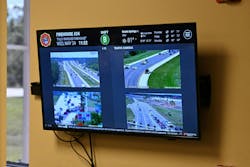If you are a tech-savvy individual, there is a high likelihood that you have added some degree of home automation or smart home controls. Biometric locks and camera systems, Wi-Fi enabled lights, appliances, controls, or even just a personal assistant device. While some of these are not ready for fire stations, there are several options that can level up the firefighter’s "home" while on shift. These five options that will help improve the quality of life, firefighter health, and safety, or provide better security and communication.
Station alerting systems with automations
Station alerting systems are not new technology, however, there are still fire stations that are not taking advantage of a system designed to improve nearly every aspect of station life. Whether you are using the most basic system that utilizes a public announcement system to broadcast the emergency notifications, or investing in automation systems, this upgrade is well worth the cost.
It amazes me that there are still stations where firefighters must listen to all the radio transmissions all day and night to pick out if it applies to them. At the core, these systems use a variety of communication methods to only activate if that station or, in some systems with multiple crews at a station, a singular crew is needed. Potentially an added justification for this investment, if done correctly, these systems can improve the department’s ISO score for having redundant circuits to dispatch. The best systems offer progressive alerts, automated station light controls, and other automations such as opening bay doors, firing up exhaust removal systems, or shutting off cooking appliances. Other options include timers meant to inform crews of turnout time. Depending on the system, automations, and options you select, this upgrade ranges from a few thousand dollars to just under $100,000.
Commercial control systems
Buildings everywhere are getting smarter with sensors and controls that reduce energy consumption, improve the indoor environment, and can even adjust without human intervention. Fire stations are the ideal location to use everything from motion sensors for lights, to full-building control systems. Imagine having a station that knows when you have a huge group of visitors and adjusts the heating, ventilation and air-conditioning system to keep everyone comfortable.
The cost of these systems varies greatly based on factors including the building size and complexity, integrations needed (especially with older equipment), level of customizations requested, and whether it includes user connectivity options such as apps. Depending on the variables, these systems will cost between $50,000 to over $1 million, although for the average sized fire station it should be between $50,000 and $125,000.
Air quality control
Air quality is a major concern in most places that are inhabited nearly 24 hours a day, 365 days per year.
Starting with the apparatus bay, apparatus exhaust is perhaps the biggest issue. While no system is perfect, there are hose-based collection systems and filtration systems. In a perfect world you would use a combination of systems to fully capture and remove carcinogens from the air. Once you move into what is commonly referred to as transition zones, using positive pressure systems that keep toxins out of the clean or living areas of the station are a fantastic addition.
The final section is one that is often overlooked. The living areas, especially in older buildings, do not have great air exchange rates. Adding advanced filtration systems in-line or as a stand-alone unit help reduce those common firehouse locker room odors, improve air quality, and can even provide some protection to airborne contaminants to include viruses and bacteria.
The exhaust removal options work great with station alerting systems that can make sure the system activates as soon as a call comes in. In any case, there are several factors that influence the price including building size and complexity, number of apparatus bays, types of hose connections needed, and level of air quality management being deployed. The initial investment for equipment installation can run from $10,000 to $100,000 per station but generally the annual cost is routine maintenance and filter changes which can be as low as $1,000 per year.
Security and access control
Fire stations are public buildings and can be considered a target of opportunity for everything ranging from trespassing and theft to terrorist events. Unfortunately, there are plenty of stories about fire stations being robbed, especially while the crew is out on a call (which may be a false alarm called in by the thief). Beyond station and apparatus equipment, this also extends to losses of personal belongings of the firefighters. Balancing aspects of being open and accessible to the community while also taking security seriously is difficult but luckily there are all kinds of tailorable solutions to assist.
Starting with access controls, there are a lot of options that allow a door to be locked without issuing keys to every member of the department. Smart door systems can use keypads with individual codes, RFID/magnetic scanners, and more recently biometric readers. With several systems doors can also be programmed to lock at certain times, have remote access options, and can even allow a dispatcher or other individual to open doors (super helpful for stations with Safe Place designations).
Smarter camera systems can be added not just as a passive deterrent but to actively monitor and alert firefighters of suspicious behavior, people, or just movement. The best systems can be incorporated with the door control systems to provide access to users who are recognized by the camera. The cost of these systems varies greatly depending on the options that are chosen but can run between $500 and $8,000 per door. One suggestion is to potentially get a system that is scalable. Start with the most critical areas such as living quarters or medication/supply storage and add additional doors as you can afford.
Status boards & visualizations
Every department in the world could improve communication with firefighters. Whether admin to staff, general messaging, or operational awareness, there are several options for station dashboards or visualizations. Some options require specialized equipment and can integrate with a department’s record management system to provide details on incidents, schedules, training, or events and activities while others just need a smart tv to function. No matter which option is used I can tell you as a retired chief there is real change that comes when you do things like publishing the list of individuals with overdue training. The wall of shame is a real thing.
What these boards are also good at doing is providing real-time information to crews as they stop to gather a momentary glimpse of the location of the emergency they have just been dispatched. Providing route information (with real time traffic predictions), preplan data, or closest hydrants can help improve operational preparedness and performance. The cost of this upgrade can range from $200 to $8,000 per status board location.
Conclusion
Fire stations are more than commercial buildings. They are often a firefighter’s home for a sizable portion of their life. Balancing the community’s needs with the living conditions and working environment for the firefighters can be difficult at times but these upgrades can provide benefits to both. In my opinion, these innovations are easy to sell to the decision makers and can greatly improve quality of life, and operational effectiveness and are well worth the investment.
About the Author

Jason Moore
Jason Moore is a 23-year veteran of the fire service who began his career with the U.S. Air Force as a fire protection specialist. Moore is involved with the International Association of Fire Chiefs’ Technology Council and is a founding member/associate director of the Indiana University Crisis Technologies Innovation Lab. He delivered presentations on implementing technology, using technology for community risk reduction and best practices to justify funding for innovative programs. Moore was the keynote speaker at FireFusion 2024 and is a member of the Firehouse Editorial Advisory Board.
